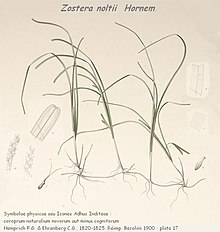Zostera noltii
| Dwarf eelgrass | |
|---|---|
 |
|
| Scientific classification | |
| Kingdom: | Plantae |
| Clade: | Angiosperms |
| Clade: | Monocots |
| Order: | Alismatales |
| Family: | Zosteraceae |
| Genus: | Zostera |
| Species: | Z. noltii |
| Binomial name | |
|
Zostera noltii Hornem. |
|
| Synonyms | |
|
Zostera noltei |
|
Zostera noltei
Zostera noltii is a species of seagrass known by the common name dwarf eelgrass. It is found in shallow coastal waters in north western Europe, the Mediterranean Sea, Black Sea, Caspian Sea and Aral Sea and on islands in the Atlantic off the coast of northwest Africa. It is an important part of the intertidal and shallow subtidal ecosystems of estuaries, bays and lagoons.
Zostera noltii has a creeping rhizome that runs along under the surface of the seabed. Groups of two to five strap-shaped leaves grow out of nodes on the rhizome and each node also bears a tuft of up to four short roots that anchor the plant in the sediment. The leaves have three irregular, longitudinal veins and blunt, notched ends. They are up to 22 cm (9 in) long and contain air spaces which make them buoyant. Several separate male and female flowers grow on a short, spear-shaped lateral stem. The smooth white seeds develop inside a green capsule with membranous walls and are about 2 mm (0.08 in) long.
Zostera noltii is found in the eastern Atlantic Ocean along the coasts of Europe as far north as Norway, Sweden and the Baltic Sea. Around the British Isles it grows extensively in the Firths of Moray and Cromarty, the Wash and the Thames Estuary. In Ireland substantial quantities are found in Strangford Lough,Dungarvan Harbour and Dublin Bay. In the Mediterranean Sea and the Black Sea, it is restricted to the brackish conditions found in lagoons and estuaries. It is the only species of seagrass found in the Caspian Sea and the Aral Sea. It also grows in Morocco, Mauritania, the Canary Islands and Cape Verde. It grows intertidally on fine sandy or muddy substrates and can tolerate various levels of salinity. It tends to grow in a band higher up the beach than Zostera marina beds and is often mixed with other seagrasses (Ruppia spp.). It grows subtidally in deeper water when it is in low salinity or brackish water in estuaries and lagoons. It is adversely affected by high nutrient levels and cloudy water.
...
Wikipedia

